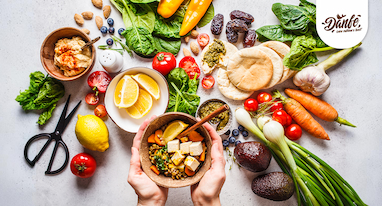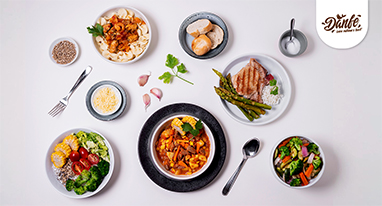Soya Wadi: Nutrition, benefits, and easy recipes
BY DANFE |
In a world of health and nutrition, a protein-rich diet is something that a lot of us try to incorporate into our monotonous eating habits. Soya chunks are popular among vegetarians because of their high protein level, which has increased over time due to a resurgent interest in high-protein diets and vegetarianism. There also has been an inclination towards vegan diets in the past few years. However, not only vegetarians but also non-vegetarians cherish the meat-like solidity and texture of Soya Wadi. No longer do non-vegetarians have to crave meat when on a vegetarian diet!
You shall find all that you need to know about Soya Wadi here, and you also get hold of some amazing Soya chunks recipes by the very end.
What exactly is Soya Wadi?
Soya wadi, which is made from soybeans, is commonly referred to as vegetarian meat because of its meaty flavor and texture. It’s commonly utilized in Indian household kitchens as part of curries and snacks due to its high protein content. Polyunsaturated lipids, proteins, and omega 3 fatty acids abound in soy. Uncooked soya chunks contain 345 calories, 52 grams of protein, 0.5 grams of total fat, 33 grams of carbs, and 13 grams of dietary fiber per 100 grams. Apart from all these benefits, it’s impeccable to notice that they’re also high in calcium and iron, and the cherry on the top of the cake is that they don’t add any sugar or sodium to the body!
(figures taken from NIFTEM)
How is it made?
Soya Wadi is prepared from dried soy flour, meaning that the oil has been removed. When dried, they are the byproducts of soybean oil extraction and have a coarse texture. However, when soaked in warm water or added to the cooked gravy, the texture instantly transforms to soft and spongy- thus giving it a meat-like consistency and chewiness
Benefits of Soya Wadi/Soya Wadi nutrition facts
We’ve already established how magically benefitting Soya Wadi is for us. However, here’s a precise set of pointers for you to absorb its benefits and usefulness.
(1) Aids in weight loss
There are two aspects to it- one, the fibers in soya wadi prevent hunger, and two, once consumed, it keeps you full for a long period of time. Soya chunks, according to HealthifyMe, have a larger thermogenic effect (energy required to digest, absorb, and metabolize meals above the basal metabolic rate) than carbs. Therefore, Soya Wadi can actually help you lose weight if you eat it in the right proportions.
(2) Risk of breast cancer and other gynecologic disorders is reduced.
Soya contains phytoestrogens, which help to reduce the effects of high estrogen in women. It also helps women with PMS and menopause-related concerns.
(3) Regulates blood sugar levels
For people who have diabetes, Soya Wadi is something that their diet must consist of. Soya Wadi has proven to be high in isoflavones, which help to decrease blood glucose, cholesterol, and other inflammatory markers. It also improves insulin sensitivity, which enhances the body’s blood sugar tolerance.
(4) A substitute for meat
Soya Wadi can be added to the diet of those who are lacking in protein. It is efficient in providing the required amount of protein, and it has no side effects.
It’s worth noting that Soya chunks contain protein like chicken or lamb does, implying that it actually is a substitute or alternative for meat.
(5) Health benefits
Soybeans and soy meals have been shown to reduce the risk of a variety of health problems, including cardiovascular disease, coronary heart disease (CHD), stroke, several malignancies, and improved bone health.
Soy is a high-quality protein that can indeed be good for our health provided we consume one or two servings per day.
(6) Prevents sleep disorders and anemia
Soya Wadi is said to be beneficial for those who are suffering from any sort of sleep disorder as Soya wadi is rich in vital minerals including magnesia, which might help you sleep better. This is one of the most crucial benefits of Soya Wadi. Apart from this, as we’ve already established that it’s rich in iron, it also helps people who have anemia.
Soya Wadi recipes to spice up a regular day!
(1) Rajasthani red pumpkin and Soya Sabzi
Every province has its own traditional style of cooking its favorite vegetables. Here’s one dish coming straight up from the warmth of Rajasthan, wrapped in bright colors of spices.
Preparation time: 30 minutes
Ingredients:
- 2 cups peeled red pumpkin cubes
- ½ cup soya wadi
- 2 tbsp oil
- 1 tbsp mustard seeds
- ½ tbsp fenugreek seeds
- 1 tbsp nigella seeds
- 2 bay leaves
- 1 small cinnamon stick
- 2 cloves
- 2 cardamoms
- ¼ tbsp asafoetida
- ½ cup chopped tomatoes
- 1 tbsp chili powder
- ½ tbsp turmeric powder
- 2 tbsp cumin-coriander seeds
- ½ tbsp sugar
- Salt to taste
- 1 tbsp lemon juice
Instructions:
- Heat oil in a non-stick saucepan and add mustard seeds, nigella seeds, fenugreek seeds, bay leaves, cinnamon sticks, and cardamoms.
- Wait for mustard seeds to crackle, then add the soya wadi to it and saute on a medium flame for about a minute or so
- Add asafoetida and continue to saute for a few more seconds
- Add in the tomatoes, chili powder, turmeric powder, cumin-coriander powder, and saute on a medium flame for about one minute
- Add red pumpkin cubes, salt, and sugar, 2 cups of water (approximately), and mix it well
- Cover the lid and let it cook on a medium flame for about 10-12 minutes till the pumpkin is cooked completely.
- Add lemon juice and mix well; serve hot!
(2) Soya Wadi salad
Olives, sweet corn, mushrooms, soya chunks, hanging curd, and lettuce leaves make up Soya Wadi Salad, a quick supper recipe. This healthy and light meal is ideal for health-conscious individuals. If you’re searching for a quick and easy dinner, this is the recipe for you. It’s also a wonderful option for vegetarians to absorb protein. Mayonnaise is used as the dressing in this salad dish, but you can use whichever dressing you prefer or like. Make wholesome salads a regular part of your diet with this delicious and healthy recipe, and take another step towards a healthy life!
Ingredients:
- 2 cup soya wadi
- 2 medium chopped capsicum ( green pepper)
- 1/2 cup drained frozen sweet corn
- 4 lettuce loose-leaf
- 2 large chopped onion
- 12 mushroom button
- 1 handful of green olives
- 1/2 cup croutons
For the toppings:
- 7 tablespoon hung curd
- 2 teaspoon cheese spread
- 4 pinches salt
- 2 teaspoon mayonnaise
- 1 teaspoon tomato ketchup
- 1 pinch of white pepper powder
Instructions:
- Soak Soya Wadi: Take a container filled with 2 glasses of water. Boil it for a minute, then soak the soya wadi for an hour or more in lukewarm water. The Soya wadi will get soft as a result of this. Drain, chill, squeeze and set aside the soya chunks for later.
- Chop the vegetables: After washing all the vegetables in cold running water, pat them dry before chopping them finely or as desired. Set them aside after you’re finished.
- Prepare the topping: Now is the moment to incorporate the salad’s flavors and give the salad its essence. In a separate bowl, combine all of the topping ingredients and keep them in the refrigerator. When the salad dressing is cold, it enhances the flavor of the salad thus bringing out the best taste of the same
- Stir fry the nuggets: Take a wok and heat it over low-medium heat. Stir-fry the prepared soya chunks in the wok until they turn golden in color. The salad recipe will have more crunch if the soya pieces are stir-fried. Set all of it aside.
- Saute the vegetables: Add in some onions and capsicums to the same wok now. Cook for a few seconds on each side to make them mildly crispy. Transfer them from the wok and place them in a bowl to cool. In the same wok, heat the mushrooms over high heat. Remove the mushroom from the heat after about a minute of stirring.
- Mix all of it: Allow the cooked veggies to cool to room temperature before serving. In a mixing dish, combine all of the vegetables with the salad leaves. Keep the bowl in the fridge for the time being.
- Layer the dressing: Just before serving, pour the dressing over the salad and top with some of the baked croutons. It’s time to eat a salad that’s both nutritious and delicious.
Serve and relish this healthy salad. Who said being healthy would make you compromise on taste? Try this recipe out and soothe your taste buds, now!




